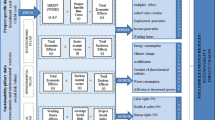Abstract
The Guanabara Bay basin, SE Brazil, is shown as an experimental site to evaluate development and sustainability in coastal areas. We developed a Driver–Pressure–State–Impact–Response (DPSIR) framework in a practical context to integrate natural and socio-economic indicators. Sustainability reflects public policies towards the utilization of natural resources. Cost-benefit analysis (CBA) included in DPSIR evaluates losses and benefits resulting from such policies. CBA has some limitations due to the difficulty of valuating environmental goods and services. Instead of valuating them we propose to combine sustainability indicators and defensive expenditures for the implementation of public policies. This approach agrees with the environmental conservation paradigm implicit in sustainable development. It allows an estimation of the physical natural capital depreciation (PNCD), by using it to correct the gross domestic product (GDP) of the study area, and demonstrating the present non-sustainable characteristics of the current policies applied to the area.



Similar content being viewed by others
Explore related subjects
Discover the latest articles and news from researchers in related subjects, suggested using machine learning.References
Barbier EB (1993) Sustainable use of wetlands valuing tropical wetland benefits: economic methodologies and applications. Geogr J 159:22–32
Bidone ED (2000) Análise econômico-ambiental aplicada à contaminação das águas fluviais de pequenas bacias costeiras do Estado do Rio de Janeiro. In: Esteves FA, Lacerda LD (eds) Ecologia de Restingas e Lagoas Costeiras. EDUFRJ, Rio de Janeiro, pp 371–394
Bidone ED, Silva Filho EV, Guerra T, Barroso LV, Ovalle ARC(1999) Natural and cultural nutrient levels in rivers of coastal lagoon catchments, state of Rio de Janeiro, Brazil. In: Knoppers BA, Bidone ED, Abrão JJ (eds) Environmental geochemistry of coastal lagoon systems of Rio de Janeiro, Brazil. Departamento de Geoquimica, Universidade Federal Fluminense, Niteroi, pp 89–106
Bidone ED, Maddock JEL, Castilhos ZC (2002) A practical method to internalize environmental impacts into cost benefit analysis. Environ Practice 4:31–35
Billen G (1993) The Phison River system: a conceptual model of C, N and P transformations in the aquatic continuum from land to sea in interactions of C, N, P and S biogeochemical cycles and global change. In: Wollast R, Mackenzie FT, Chou L (eds) NATO ASI series I: global environmental change. Springer, Berlin Heidelberg New York, pp 141–161
Campos ED, Bidone ED (2000) Potential ecological risk index for heavy metals: assay at Guanabara Bay, Rio de Janeiro, Brazil. In: Proc 25th Int Conf Heavy Metals in the Environment, Ann Arbor, Michigan, USA, available in CD-ROM
Carvalho CEV, Lacerda LD (1992) Heavy metals in the biota of Guanabara Bay: why such low concentrations. Ciênc Cult 44:184–186
Castilhos ZC, Bidone ZC, Hartz S (2003)Bioaccumulation of Hg by Tucunaré (Cichla ocellaris) from Tapajós River region, Brazilian Amazon. A field dose-response approach. Bull Environ Contam Toxicol 66:631–637
Costanza R (1991) Ecological economics, the science and management of sustainability. Columbia University Press, South Carolina
El Serafy S (1991) The environment as capital. In: Costanza R (ed) Ecological economics, the science and management of sustainability. Columbia University Press, South Carolina, pp 168–175
Håkanson L (1988) Metal monitoring in coastal environments. In: Seeliger U, Lacerda LD, Patchineelam SR (eds) Metals in coastal environments of Latin America. Springer, Berlin Heidelberg New York, pp 240–257
Håkanson L (1980) An ecological risk index for aquatic pollution control: a sedimentological approach. Water Res 14:975–1001
Heal G (2000) Valuing ecosystem services. Ecosystems 3:24–30
Hueting R (1991) Correcting national income for environmental losses: a practical solution for a theoretical dilemma. In: Costanza R (ed) Ecological economics. Columbia University Press, South Carolina, pp 194–213
Japan International Cooperation Agency (1994) The study on recuperation of the Guanabara Bay ecosystem. Main report. JICA, Yokohama
Kjerfve B, Dias GT (1997) Physical oceanography of Guanabara Bay. Cont Shelf Res 17:1609–1643
Kopp RJ, Krupnick AJ, Toman M (1997) Cost-benefit analysis and regulatory reform: an assessment of the science and the art. In: Proc Conf Resources for the Future, January, Washington, Discussion Pap 97–19
Kremer HH, Salomons W, Crossland CJ (2002) Human dimensions of land-based fluxes to the coastal zone: the LOICZ-Basins approach. In: Lacerda LD, Kremer HH, Kjerve B, Salomons W, Marshall Crossland JI, Crossland CJ (2002) South American Basins: LOICZ global change assessment and synthesis of river catchments–coastal sea interaction and human dimensions. LOICZ reports and studies no 21. LOICZ, Texel, The Netherlands, pp 61–77
Lacerda LD, Kremer HH, Kjerve B, Salomons W, Marshall Crossland JI, Crossland CJ (2002) South American Basins: LOICZ global change assessment and synthesis of river catchments–coastal sea interaction and human dimensions. LOICZ reports and studies no 21. LOICZ, Texel, The Netherlands
Molisani M, Marins RV, Machado W, Paraquetti HHM, Lacerda LD (2003) Environmental changes in Sepetiba Bay, SE Brazil. Reg Environ Change (in press)
Organization for Economic Cooperation and Development (1994) Environmental indicators: OECD core set. OECD, Paris
Pearce DW, Turner RK (1990) Economics of natural resources and the environment. Harvester Wheatsheaf, London
Peskin HM (1989) A proposed environmental accounts framework. In: Proc Environmental Accounting for Sustainable Development, UNEP–World Bank Symp, Washington, pp 65–78
Turner RK, Adger WN, Lorenzoni I (1998) Towards integrated modeling and analysis in coastal zones: principles and practices. LOICZ reports and studies no 11. LOICZ, Texel, The Netherlands, pp 1–122
World Bank (1992) World development report: development and environment. Oxford University Press, New York
World Commission on Environment and Development (1987) Our common future—The Brundtland Report. WCED, Gland
Author information
Authors and Affiliations
Corresponding author
Rights and permissions
About this article
Cite this article
Bidone, E.D., Lacerda, L.D. The use of DPSIR framework to evaluate sustainability in coastal areas. Case study: Guanabara Bay basin, Rio de Janeiro, Brazil. Reg Environ Change 4, 5–16 (2004). https://doi.org/10.1007/s10113-003-0059-2
Received:
Accepted:
Published:
Issue Date:
DOI: https://doi.org/10.1007/s10113-003-0059-2




